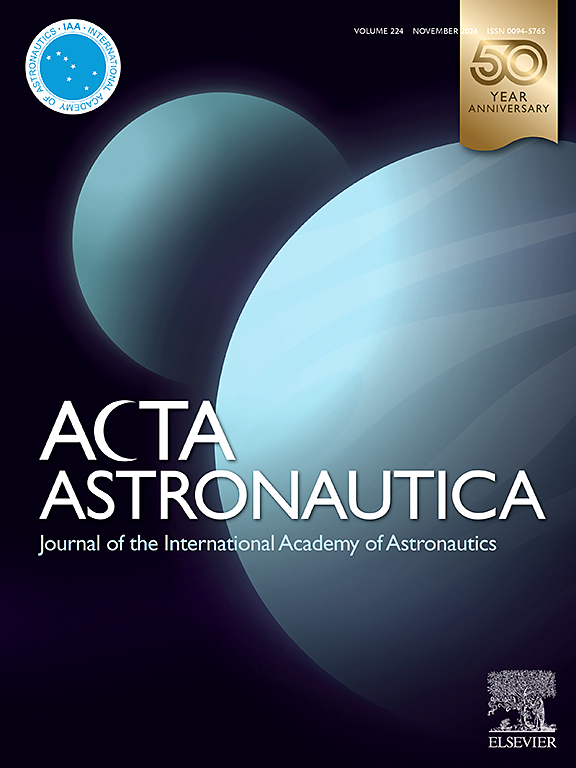Space-based debris trajectory estimation using vision sensors and track-based data fusion techniques
IF 3.1
2区 物理与天体物理
Q1 ENGINEERING, AEROSPACE
引用次数: 0
Abstract
Resident Space Objects (RSO) are human-made objects in orbit around Earth and can remain there for an extended period. These objects can include active satellites, rockets, and space stations, as well as debris caused by previous space endeavours. Debris originated as a consequential outcome of activities such as space launches, orbital missions and collision events, pose a formidable threat to currently operational space assets. To reduce the risk of on-orbit collisions, it is imperative that spacecraft operators enhance their situational awareness concerning potential threats posed by RSO. This necessitates comprehensive tracking of the total number of objects in space and the continuous estimation of the probability of accidental collisions. Effective Collision Avoidance (CA) manoeuvres rely on accurate tracking and characterization of RSO. Currently, RSO are monitored and catalogued using ground-based observational systems. However, Space-Based Space Surveillance (SBSS) presents a viable solution for tracking the RSO, providing superior sensor resolution, tracking accuracy, and independence from weather conditions. Accurate and continuous orbit determination of RSO is critical for developing a robust framework that enables accurate prediction of RSO dynamics. This capability is essential for applications such as Interplanetary space exploration, space tourism and Point-To-Point Suborbital Transport (PPST), which are anticipated in the future. The current study proposes a multi-sensor data fusion strategy designed to integrate angular measurements extracted from image sequences obtained by multiple cost-effective Electro-Optical Sensors (EOS) sensors deployed in SBSS missions. The main contribution of this study lies in the development of data fusion frameworks tailored for constrained computational environments, ensuring seamless real-time implementation on intelligent Distributed Satellite Systems (iDSS). This study proposes and rigorously compares three distinct data fusion methodologies—Measurement Fusion-1 (MF-1), Measurement Fusion-2 (MF-2), and Track-to-Track (T2T) fusion—examining their impact on tracking accuracy across varying sensor-to-target geometries. Additionally, the data fusion framework is validated under diverse operational conditions, including Ground-Based Space Surveillance (GBSS), SBSS, and the synergistic integration of GBSS and SBSS. A validation case study is conducted on an iDSS constellation executing a SBSS mission. The results indicate that MF-1 outperforms other algorithms in the SBSS scenario in terms of tracking accuracy. In contrast, T2T fusion demonstrates superior performance in terms of computational time. Notably, the integration of SBSS and GBSS data surpasses the performance of GBSS across all evaluated data fusion methodologies.
驻留空间物体(RSO)是环绕地球轨道上的人造物体,可以在那里停留较长时间。这些物体包括现役卫星、火箭和空间站,以及以前的空间活动造成的碎片。碎片是空间发射、轨道飞行任务和碰撞事件等活动的后果,对目前运行的空间资产构成巨大威胁。为了降低在轨碰撞的风险,航天器运营商必须加强对 RSO 潜在威胁的态势感知。这就需要对太空中的物体总数进行全面跟踪,并持续估算意外碰撞的概率。有效的避免碰撞(CA)操作依赖于对 RSO 的精确跟踪和特征描述。目前,利用地面观测系统对 RSO 进行监测和编目。然而,天基空间监视系统(SBSS)为跟踪 RSO 提供了一个可行的解决方案,它具有卓越的传感器分辨率和跟踪精度,并且不受天气条件的影响。对 RSO 进行精确和连续的轨道测定对于开发一个能够准确预测 RSO 动态的强大框架至关重要。这种能力对于行星际空间探索、太空旅游和点对点亚轨道运输(PPST)等应用至关重要,而这些应用在未来是可以预见的。本研究提出了一种多传感器数据融合策略,旨在整合 SBSS 任务中部署的多个经济高效的电子光学传感器(EOS)所获得的图像序列中提取的角度测量值。本研究的主要贡献在于开发了针对受限计算环境的数据融合框架,确保在智能分布式卫星系统(iDSS)上无缝实时实施。本研究提出并严格比较了三种不同的数据融合方法--测量融合-1(MF-1)、测量融合-2(MF-2)和跟踪-跟踪(T2T)融合--研究它们对不同传感器-目标几何尺寸的跟踪精度的影响。此外,数据融合框架还在不同的运行条件下进行了验证,包括地基空间监视(GBSS)、SBSS以及GBSS和SBSS的协同集成。对执行 SBSS 任务的 iDSS 星群进行了验证案例研究。结果表明,在 SBSS 情景下,MF-1 的跟踪精度优于其他算法。相比之下,T2T 融合在计算时间方面表现更优。值得注意的是,在所有评估过的数据融合方法中,SBSS 和 GBSS 数据的融合性能超过了 GBSS。
本文章由计算机程序翻译,如有差异,请以英文原文为准。
求助全文
约1分钟内获得全文
求助全文
来源期刊

Acta Astronautica
工程技术-工程:宇航
CiteScore
7.20
自引率
22.90%
发文量
599
审稿时长
53 days
期刊介绍:
Acta Astronautica is sponsored by the International Academy of Astronautics. Content is based on original contributions in all fields of basic, engineering, life and social space sciences and of space technology related to:
The peaceful scientific exploration of space,
Its exploitation for human welfare and progress,
Conception, design, development and operation of space-borne and Earth-based systems,
In addition to regular issues, the journal publishes selected proceedings of the annual International Astronautical Congress (IAC), transactions of the IAA and special issues on topics of current interest, such as microgravity, space station technology, geostationary orbits, and space economics. Other subject areas include satellite technology, space transportation and communications, space energy, power and propulsion, astrodynamics, extraterrestrial intelligence and Earth observations.
 求助内容:
求助内容: 应助结果提醒方式:
应助结果提醒方式:


